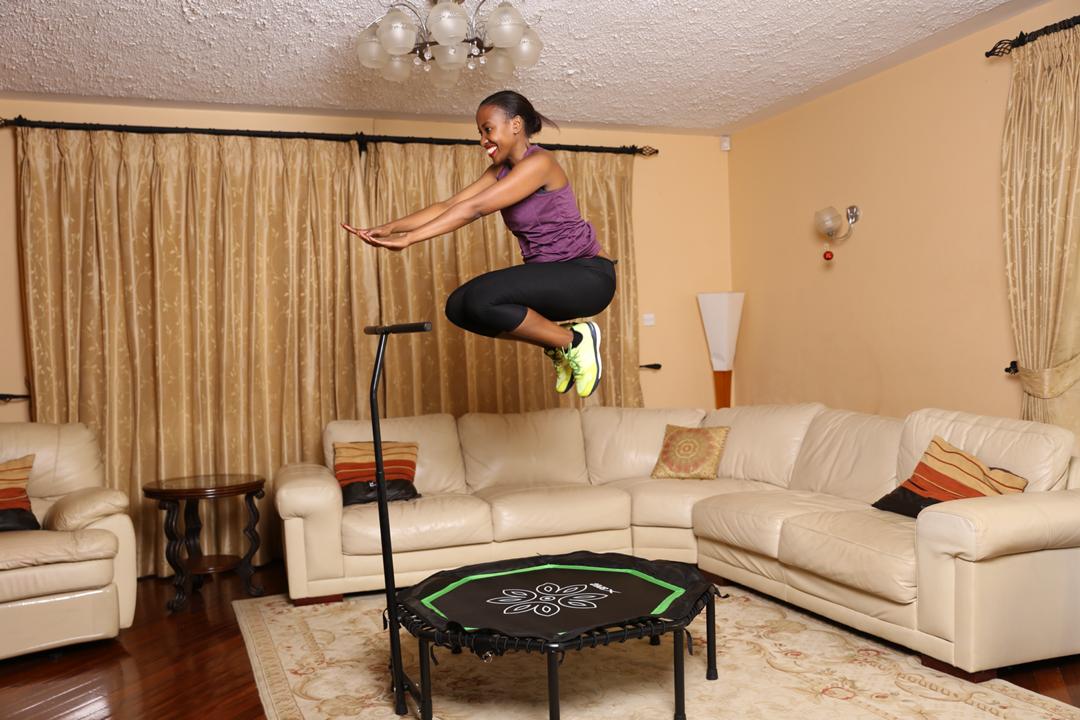
Finding the perfect fitness equipment for your home can be challenging due to the overwhelming number of choices and options available, especially when similar products go by different names. This is the case with trampolines and rebounders, which are related products that vary in form and function. If you’re feeling confused, it’s understandable!
What is a trampoline?
A trampoline is a device that serves as a springboard for jumping. Its fundamental components are a sturdy piece of fabric, known as the trampoline mat, which is stretched over a raised metal or steel frame, and the springs, which work together with the mat and frame to create a bouncing effect.
Trampolining can be both a leisure activity and a competitive sport. People of all ages can enjoy trampolining as a fun, energetic form of exercise. Professional and amateur gymnasts also use trampolines to practice and perfect their skills before competitions.
There are various types of trampolines available in different shapes and sizes. While many people associate garden trampolines with round or rectangular shapes, there are other defining features to consider.
The classic type of trampoline is the round trampoline, which is often chosen as a recreational option for home gardens. Ranging in diameter from eight to sixteen feet, these trampolines can come with or without a net, and the center is the best spot to achieve the highest bounce.
A big rectangular trampoline is a popular option for families and semi-professional gymnasts who want to practice tricking and gymnastics. As the trampoline gymnastics played at the Olympics is on large rectangular trampolines, this shape provides an authentic feel for practice. With a robust fabric that can bear heavier weight, you can experience an equal bounce on all parts of the trampoline, resulting in higher jumping. Rectangular trampolines are typically medium to large.
At Thrifty, we are well-known for our round and rectangular trampolines, which offer innovation, performance, and better bounce.
While round and rectangular trampolines are the most common types, there are trampolines in other shapes and styles available, such as square, oval, and hexagonal. Trampolines can be above or in-ground, with larger outdoor trampolines primarily used for gymnastics practice.
What is a rebounder
A Rebounder is a compact fitness trampoline that elevates the indoor workout experience. Unlike traditional trampolines, a Rebounder offers a unique bounce that provides greater resistance. This means that using a Rebounder engages your muscles while bouncing, resulting in a more effective workout. Essentially, a Rebounder is specifically designed to maximize your exercise routine while bouncing.
Types of Rebounders
Rebounders are lightweight and convenient for home use, making them ideal for low-impact aerobic exercises suitable for a single person. They come in two main types – basic and handlebar – with distinct features to suit different workout needs.
Basic Rebounders
The regular type of rebounder, smaller than mini trampolines, is perfect for fitness enthusiasts who prefer stretching and low-impact exercises. The gravitational pull on a rebounder increases the body weight impact, offering a more effective workout. Basic rebounders are equipped with bungee cords instead of springs to protect and support ligaments and joints, and their bounce is deeper and gentler.
Rebounders with a Handlebar
These rebounders have all the features of basic rebounders, but they also come with a handlebar for added flexibility and stability during exercises. With a handlebar, you can perform complex and intense moves while maintaining balance and support. Whether bouncing or stretching on the rebounder, the handlebar provides extra support to maximize the health benefits of a well-rounded workout.
Basic misconceptions about Trampolines and Rebounders
There are several misconceptions about trampolines, rebounders, and mini trampolines. Here are two of the most common ones:
Mini trampolines and rebounders are the same – this is incorrect. Although the terms are sometimes interchangeable, mini trampolines and rebounders have different designs and functions. Mini trampolines usually use springs, giving them a bounce similar to a regular trampoline. They can be used for recreational purposes, such as jumping and tricking. In contrast, rebounders are typically made with bungee cords, and their bounce is less high than that of a regular or mini trampoline. Rebounders are primarily used for fitness purposes.
Rebounders are safer than trampolines – this is also incorrect. Whether it is a regular trampoline or a rebounder, trampoline safety is a crucial consideration in the design process. There are three essential components of trampoline safety, which you can read about in our safety blog article. Reputable trampoline manufacturers implement these protocols to ensure the safety of their products’ users.

